Youth Initiation
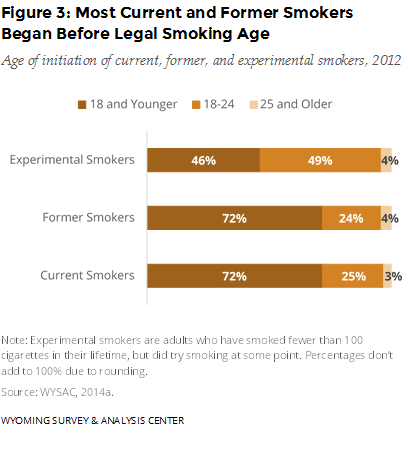 Initiation as Reported by Smokers
Initiation as Reported by Smokers
Smoking initiation is defined as the age at which a person first smokes one whole cigarette. According to the Wyoming YRBS (2015), more students in 10th, 11th, and 12th grades reported smoking initiation at 15 or 16, compared to other ages.
Most Wyoming adults who are or have been smokers began smoking before the legal age of 18. Few smokers, former smokers, or experimental smokers reported starting smoking after the age of 24 (Figure 3). Among current smokers, the age of smoking initiation appears to be increasing. Between 2010 and 2012, the percentage of current smokers who reported first smoking a whole cigarette before turning 18 decreased by 14 percentage points. In the same timeframe, the percentage of smokers who reported first smoking a cigarette between the ages of 18 and 24 increased by 13 percentage points (WYSAC, 2014a).
Experimental smokers have smoked fewer than 100 cigarettes in their lifetime, but did try smoking at some point. Similar percentages of experimental smokers first smoked a cigarette before the legal age of 18 and between the ages of 18 and 24 (WYSAC, 2014a).
Preventing Youth Access
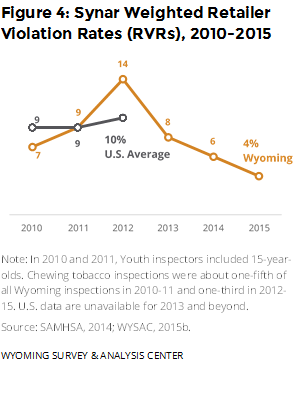 Part of the approach to preventing youth initiation of tobacco use is to limit access to tobacco products (Centers for Disease Control and Prevention, Office on Smoking and Health [CDC-OSH], 2014). SAMHSA requires states to complete annual, random, unannounced inspections of tobacco retailers, known as Synar inspections. SAMHSA requires the noncompliance rate for Synar inspections to be below 20% (SAMHSA, 2010).
Part of the approach to preventing youth initiation of tobacco use is to limit access to tobacco products (Centers for Disease Control and Prevention, Office on Smoking and Health [CDC-OSH], 2014). SAMHSA requires states to complete annual, random, unannounced inspections of tobacco retailers, known as Synar inspections. SAMHSA requires the noncompliance rate for Synar inspections to be below 20% (SAMHSA, 2010).
During Wyoming’s Synar inspections, trained 16- and 17-year old inspectors use standardized protocols to attempt to purchase cigarettes or smokeless tobacco from a sample of Wyoming tobacco retailers accessible to minors. Violations during Synar inspections do not result in actual sales, so citations are not issued.
Wyoming’s Synar results have been similar to the national violation rates (Figure 4). In 2012, Wyoming’s Synar noncompliance rate was unusually high at 14% because one geographic area had a high violation rate. Since 2007, clerks not asking inspectors for identification has been the strongest predictor of retailer violations (WYSAC, 2015b).
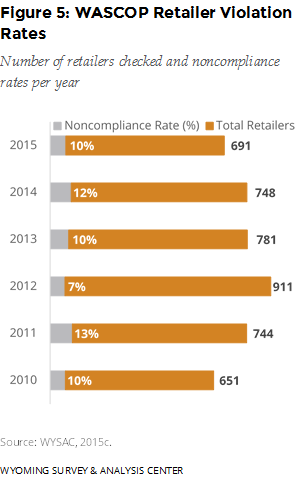 Each year, the Wyoming Association of Sheriffs and Chiefs of Police (WASCOP) conducts inspections of tobacco retailers. During WASCOP inspections, adolescent inspectors attempt to purchase cigarettes. Unlike Synar inspections, these compliance checks allow law enforcement officers to issue citations to merchants who sell to minors. Violation rates are generally slightly higher for WASCOP inspections (Figure 5) than Synar inspections (WYSAC, 2015c).
Each year, the Wyoming Association of Sheriffs and Chiefs of Police (WASCOP) conducts inspections of tobacco retailers. During WASCOP inspections, adolescent inspectors attempt to purchase cigarettes. Unlike Synar inspections, these compliance checks allow law enforcement officers to issue citations to merchants who sell to minors. Violation rates are generally slightly higher for WASCOP inspections (Figure 5) than Synar inspections (WYSAC, 2015c).
Even though retailers are generally compliant with laws restricting youth access to tobacco products (WYSAC, 2015b, 2015c), data show that underage youth access tobacco despite legal restrictions. Sources include relatives, unrelated adults or minors, buying it themselves, taking it, and other non-specified sources (Prevention Needs Assessment [PNA], 2014; YRBSS, 2015).
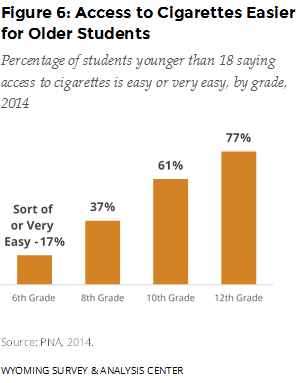 In 2014, 27% of Wyoming middle school students and 65% of Wyoming high school students under the age of 18 said it would be easy (either sort of easy or very easy) to get some cigarettes. Students in higher grades reported easier access to cigarettes than students in lower grades (Figure 6; PNA, 2014). Synar compliance checks in Wyoming have shown that clerks are more likely to sell tobacco to older or older-looking minors (WYSAC, 2015b). Together, these findings suggest that it is easier for youth to purchase or otherwise access cigarettes as they approach the age of 18.
In 2014, 27% of Wyoming middle school students and 65% of Wyoming high school students under the age of 18 said it would be easy (either sort of easy or very easy) to get some cigarettes. Students in higher grades reported easier access to cigarettes than students in lower grades (Figure 6; PNA, 2014). Synar compliance checks in Wyoming have shown that clerks are more likely to sell tobacco to older or older-looking minors (WYSAC, 2015b). Together, these findings suggest that it is easier for youth to purchase or otherwise access cigarettes as they approach the age of 18.
Increasing the price of tobacco products, usually by increasing taxes, is another strategy to reduce youth initiation of tobacco use (CDC-OSH, 2014; Chaloupka, Yurekli, & Fong, 2012; Guide to Community Preventive Services, 2015). The federal cigarette excise tax has been $1.01 per pack since April 1, 2009. Wyoming last raised the state cigarette excise tax on July 1, 2003, when the rate increased from $0.12 to $0.60 per pack. State tax rates vary considerably with a low of $0.17 per pack in Missouri to a high of $4.35 per pack in New York (Figure 7). As of January 1, 2016, the average state tax rate on cigarettes was $1.63 (not including the federal tax; Orzechowski & Walker, 2015). Wyoming’s tax is the 8th lowest in the nation (tied with the tobacco-producing state of Kentucky; CDC, 2016).
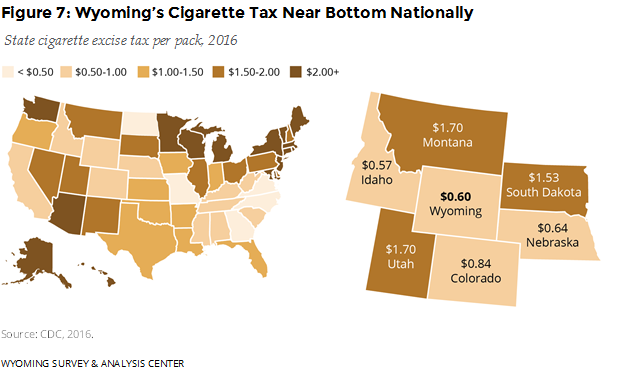
Consistent with every state that has implemented a significant cigarette tax increase (Farrelly Nimsch, & James, 2003), Wyoming experienced a decrease in cigarette consumption and an increase in tax revenue when it last raised its cigarette excise tax on July 1, 2003. Wyoming’s cigarette tax revenue increased from $5.1 million (equivalent to $6.6 million today, adjusting for inflation) in the fiscal year before the tax increase took effect to $19.1 million in fiscal year 2014 (Wyoming Department of Revenue [WYDOR], ca. 2014). WYSAC generated a statistical model based on data from 1996 through 2014 that predicts that an additional $1.00 tax increase per pack could generate a total tax revenue of $48.3 million during the first year (WYSAC, 2014c).

